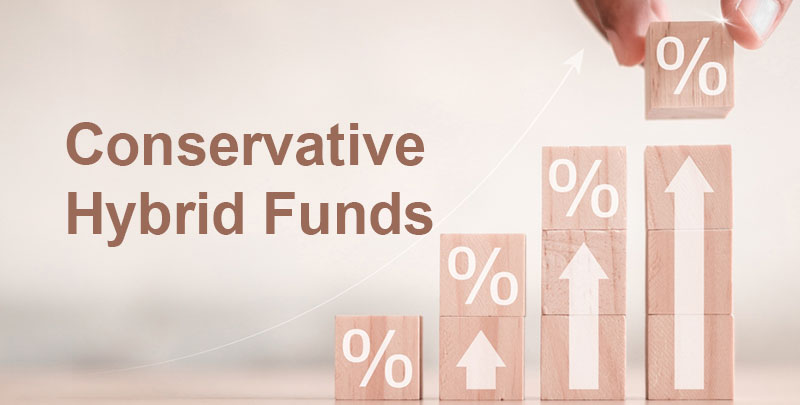Conservative Hybrid Funds are like a balanced recipe for a healthy meal. Most of the ingredients are safe and steady
(like bonds), which makes the dish reliable. A small part is made up of spicy ingredients (stocks), which add
flavour (growth) over time. This mix helps you enjoy a meal that’s both filling and delicious, without the risk of
it being too overwhelming. It’s perfect if you want a steady yet flavourful way to grow your money.
What are Conservative Hybrid Funds?
Conservative Hybrid Funds are Mutual Funds that invest primarily in debt instruments (such as bonds and fixed-income
securities) with a small portion allocated to equities (stocks).
Conservative Hybrid Funds invest around 75-90% in debt, providing stability and predictable returns, while the
remaining 10-25% in equities allows for potential growth.
These funds are designed for conservative investors who seek a steady income with lower volatility compared to
equity-heavy funds. The debt portion acts as a cushion against market fluctuations, while the equity exposure adds
an element of capital appreciation.
Conservative Hybrid Funds are ideal for investors with a medium-term investment horizon, such as those saving for
goals like retirement or education, and for individuals who are risk-averse but still want some growth. They are
suitable for investors looking for a balanced, lower-risk investment strategy.
Features of Conservative Hybrid Funds
- Primarily invest in debt instruments: Conservative Hybrid Funds focus mostly on bonds and
fixed-income securities, ensuring safety and stable returns.
- Small equity exposure: A smaller portion (typically 10-25%) is invested in stocks, providing
growth potential without high volatility.
- Low risk: By balancing the portfolio with more stable debt investments, Conservative Hybrid
Funds tend to have lower risk compared to equity-heavy funds.
- Active management: Experienced fund managers actively adjust the mix of bonds and stocks,
optimising the portfolio based on market conditions.
- Ideal for conservative investors: Conservative Hybrid Funds are tailored for investors who are
risk-averse or have a medium-term horizon.
Benefits of Conservative Hybrid Funds
- Steady income: The focus on bonds ensures a consistent income stream with lower risk, making it
ideal for conservative investors.
- Balanced growth: The equity component offers growth potential, but in a controlled way that
balances stability with gradual appreciation.
- Reduced market volatility: By relying more on debt, these funds help reduce the impact of stock
market swings, providing a smoother investment experience.
- Diversification: Investing in both stocks and bonds helps spread out risk, making the portfolio
diversified and less susceptible to losses.
- Goal-oriented investors: Conservative Hybrid Funds are great for those looking to achieve
specific financial goals, like funding an emergency fund or saving for short-term needs.
How do Conservative Hybrid Funds work?
Conservative Hybrid Funds operate by creating a balanced portfolio. Fund managers mainly invest in debt instruments
like government securities and corporate bonds. This helps them in capital preservation. The remaining portion is
invested in equities to offer potential for long-term growth. The objective is to offer stable returns with
controlled risk.
How to invest in a Conservative Hybrid Fund?
- Assess your risk profile and goals: Understand your financial goals and how much risk you are
willing to take. Conservative Hybrid Funds suit low-risk investors.
- Choose the appropriate fund: Compare different Conservative Hybrid Funds based on their past
performances, fund manager's experience, expense ratios, and asset allocations.
- Select investment mode: It can be an SIP or a lump sum. Decide whether you want to invest a
lump sum or start a Systematic Investment Plan (SIP) to invest monthly in smaller amounts.
- Track and review: Monitor your Conservative Hybrid Fund’s performance periodically. Stay
invested for a few years to get the best results with stability and moderate growth.
Taxation rules of Conservative Hybrid Funds
Conservative Hybrid Funds are taxed like Debt Mutual Funds in India. Hence, all capital gains are taxed at the
applicable income tax slab rates, irrespective of the holding period. Dividends, in case of IDCW plan, are added to
your income and taxed according to your slab rate.
Also Read: Expense ratio
in Mutual Fund: Meaning, components & calculation
Conclusion
Conservative Hybrid Funds are a good choice for investors who seek a balance between low risk and steady growth. With
a major focus on debt allocation and a small equity exposure, these funds offer capital preservation and income
generation, making them ideal for conservative investment goals. Explore great options for easy investing on Axis
Bank’s digital platforms.
Disclaimer: This article is for information purpose only. The views expressed in this article
are personal and do not necessarily constitute the views of Axis Bank Ltd. and its employees. Axis Bank Ltd.
and/or the author shall not be responsible for any direct / indirect loss or liability incurred by the reader
for taking any financial decisions based on the contents and information. Please consult your financial advisor
before making any financial decision.
Mutual Fund investments are subject to market risk, read all scheme related documents carefully. Axis Bank Ltd
is acting as an AMFI registered MF Distributor (ARN code: ARN-0019). Purchase of Mutual Funds by Axis Bank’s
customer is purely voluntary and not linked to availment of any other facility from the Bank. T&C apply.








